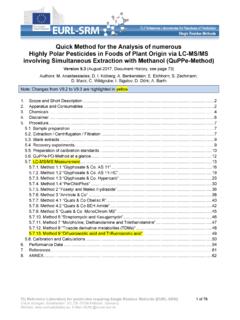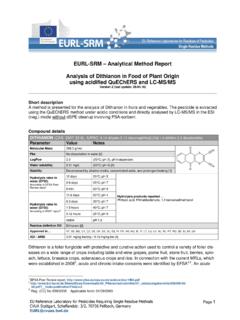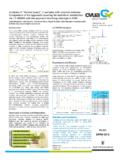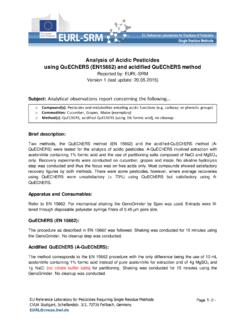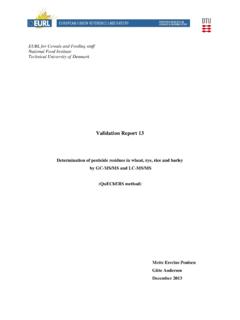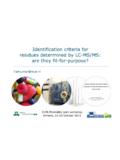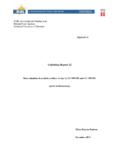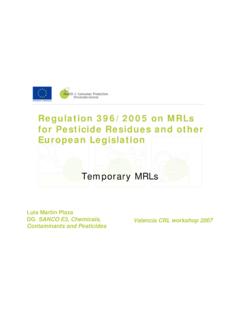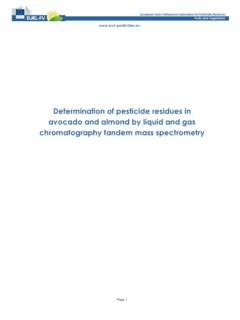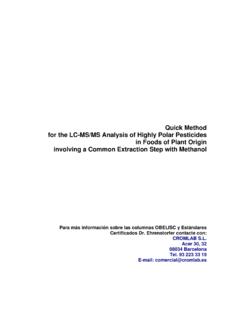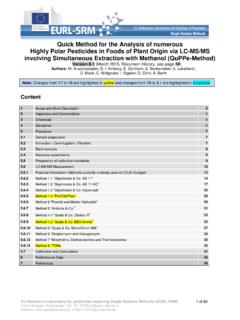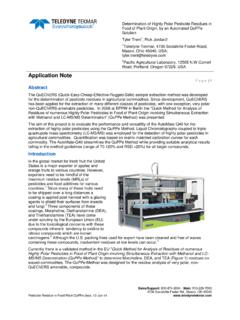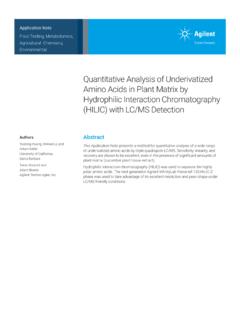Transcription of Fosetyl and Phosphonic acid - EURL | Pesticides
1 Fosetyl and Phosphonic acid . Residue Situation and some Interesting Facts Kathi Hacker, Anne Benkenstein, Eric Eichhorn, Diana Kolberg, Cristin Wildgrube, Ellen Scherbaum and Michelangelo Anastassiades EURL-SRM. E-Mail: Introduction Analytical method Residues of Phosphonic acid in crops can occur Phosphonic acid and Fosetyl are extracted by the as a result of the application of plant protection QuPPe method. While Phosphonic acid is products (PPPs) containing Phosphonic acid itself measured by the PerChloPhos method (No. ), or via the application of Fosetyl -Al, which degrades Fosetyl is analysed via method Glyphosate &. to Phosphonic acid . To reflect this, the current residue definition of Fosetyl -Al is defined in the EU When analyzing for Phosphonic acid and Fosetyl as follows: "sum of Fosetyl , Phosphonic acid and there are some important aspects to keep in mind: their salts, expressed as Fosetyl ".
2 We recommend the separated measurement O due to formation of Phosphonic acid from Fosetyl Degradation product O 3+ both in solution and through in-source Al P HO P OH fragmentation. This can be easily seen by In-source - H3C O O. H measuring Fosetyl -D5 solution. The chomatogram fragment H. 3 on the right shows two peaks at the mass trace Fosetyl -Al Phosphonic acid of Phosphonic acid . Phosphonic acid 81/79. From January 2014 to December 2015 a total of Many samples naturally contain high 4265 samples of different commodity types of concentrations of phosphoric acid , which is co- plant origin were separately analyzed for residues extracted during the sample preparation process. of Fosetyl and Phosphonic acid . Analysis was The chromatographic separation of Phosphonic accomplished by the QuPPe-Method involving acid from phosphoric acids is often compromised extraction by acidified methanol, filtration, dilution resulting in a suppression of the Phosphonic acid and LC-MS/MS in the ESI negative mode using signal and in some cases even leads to false the Hypercarb column.
3 Negative results. In addition, the qualifier mass- trace of Phosphonic acid (m/z 81/63) is interfered Results and Summary by phosphoric acid , due to in-source fragmentation of the latter. Overall, 36% of all the analyzed samples contained residues of Fosetyl and/or Phosphonic acid above the LOQ, with Phosphonic acid being ca. 40x more frequently detected than Fosetyl . 97/63 81/63 81/79. Conventionally grown products contained Phosphonic acid at levels exceeding the LOQ. more frequently than products labelled as organic (39% vs. 17%) see tables of the main findings in unique to Phosphoric acid common to Phosphoric unique to Phosphonic acid conventional and organic products. and Phosphonic acid Table I Phosphonic acid and Fosetyl findings in CONVENTIONAL products Commodity Number of No.
4 Of samples containing No. of samples No. of samples Minimum and maximum contents of Although m/z 81/63 is a very minor transition of phosphoric acid its interference on Phosphonic containing conventional samples Phosphonic exceeding the MRL Phosphonic acid and production Fosetyl acid Fosetyl [mg/kg]. Babyfood on 12 7 (58%) 4 acid can be very significant due to the typically fruitbasis Berry fruits 572 377 (66%) 11 (grapes). 2 high levels of phosphoric acid in samples. By Pome fruits 202 141 (70%). (blackberries) - diluting the sample extracts, the Stone fruits 260 92 (35%). 5. (3x nectarines, - chromatographic separation considerably cherries, avocados). improves allowing proper peak integration next - Citrus fruits 194 138 (71%) 1 (lemons). to the high levels of Phosphoric acid .
5 Fortunately Exotic fruits 297 113 (38%) 3 (2x kiwis, mangos) Phosphonic acid has additionally a mass- transition (m/z 81/79), which is only negligibly 5 (2x tomatos, Fruiting 647 182 (28%) cucumbers, vegetables zucchinis, melons). 7 (4x rucola, pak- interfered, thus allowing proper identification and 3 (2x basil, cabbages, Leafy vegatables 712 181 (25%) choy, 2x lettuce). rucola, spinach) accurate quantification. The elution time and Stem vegetables 226 49 (22%). 1. (stem cabbage). peak shape of the ILIS (18O3- Phosphonic acid ). Root vegetables 176 28 (16%). 3 (2x root celery, parsnip). can also be used to distinguish Phosphonic from phosphoric acid . Potatoes 55 13 (24%) Dry pulses and 68 20 (29%) 3 (3x rice) cereals Fungi 144 37 (26%) 0,087 - 8,5. 0,16 - 12,1 Table II Phosphonic acid findings in ORGANIC products Wine 31 24 (77%) 4.
6 0,025 0,040. Commodity No. of samples Minimum and 0,026 4,0 Number of No. of samples Fruit juice 31 30 (97%) 8 (grape juice) containing Phosphonic maximum contents 0,016 0,066 samples exceeding the MRL. organic production acid * [mg/kg]. Despite the clear classification of Phosphonic acid Babyfood on 29 14 (48%) 8 - fruitbasis as a synthetic pesticide, the frequency of findings Berry fruits 64 20 (31%) in organic products is still remarkably high. The Pome fruits 31 6 (19%) highest levels of Phosphonic acid were detected in Stone fruits Citrus fruits Exotic fruits 23. 36. 20. 5 (22%). 10 (28%). 6 30%). 1 (cherries). 1 (bananas). EPRW 2016. leafy vegetables (highest value: >150 mg/kg), Fruiting veg. 110 17 (15%) grapes, berries and pears. The highest frequency Leafy veg.
7 Stem veg. 99. 39. 3 (3%). 4 (10%) 1 (fennel). of Fosetyl findings were encountered in rucola Dry pulses and cereals 38 10 (26%) (highest value: < mg/kg) and grapes (also * No Fosetyl was detected in samples of organic production grape products). We suspect that Fosetyl is formed Reference as an artefact during production or storage of Quick Method for the Analysis of numerous Highly Polar Pesticides in Foods of Plant Origin via LC-MS/MS involving Simultaneous Extraction with Methanol wine. (QuPPe-Method), Version , May 2016.
